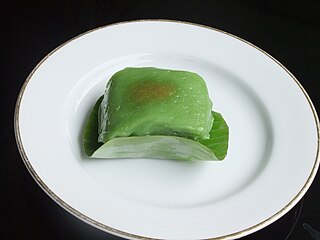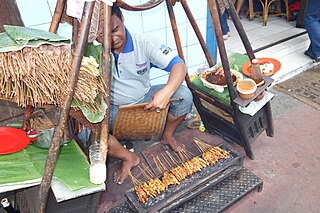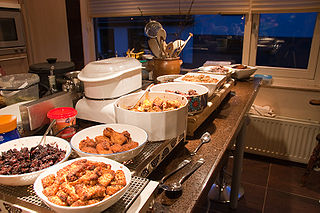
Glutinous rice is a type of rice grown mainly in Southeast and East Asia, and the northeastern regions of South Asia, which has opaque grains, very low amylose content, and is especially sticky when cooked. It is widely consumed across Asia.

Malay cuisine is the traditional food of the ethnic Malays of Southeast Asia, residing in modern-day Malaysia, Indonesia, Singapore, Brunei, Southern Thailand and the Philippines as well as Cocos Islands, Christmas Island, Sri Lanka and South Africa.

Kuih are bite-sized snack or dessert foods commonly found in Southeast Asia and China. It is a fairly broad term which may include items that would be called cakes, cookies, dumplings, pudding, biscuits, or pastries in English and are usually made from rice or glutinous rice. In China, where the term originates from, kueh or koé (粿) in the Min Nan languages refers to snacks which are typically made from rice but can occasionally be made from other grains such as wheat. The term kuih is widely used in Malaysia, Brunei, and Singapore, kueh is used in Singapore and Indonesia, kue is used in Indonesia only, all three refer to sweet or savoury desserts.

An appa or appam is a type of thin pancake originating from South India and Sri Lanka. It is made with fermented rice batter and coconut milk, traditionally cooked in an appachatti, a deep pan similar in shape to a wok. It is part of Tamil cuisine and Kerala cuisine found in the Indian states of Tamil Nadu and Kerala, and in Sri Lanka. Appam is most frequently served for breakfast or dinner, often with a topping such as an egg.

Bibingka commonly refers to a type of baked rice cake from the Philippines that is traditionally cooked in a terracotta oven lined with banana leaves and is usually eaten for breakfast or as merienda especially during the Christmas season. It is also known as bingka in the Visayas and Mindanao islands.

A rice cake may be any kind of food item made from rice that has been shaped, condensed, or otherwise combined into a single object. A wide variety of rice cakes exist in many different cultures in which rice is eaten. Common variations include cakes made with rice flour, those made from ground rice, and those made from whole grains of rice compressed together or combined with some other binding substance.

In Vietnamese, the term bánh translates loosely as "cake" or "bread", but refers to a wide variety of prepared foods that can easily be eaten by hands or chopsticks. With the addition of qualifying adjectives, bánh refers to a wide variety of sweet or savory, distinct cakes, buns, pastries, sandwiches, and other food items, which may be cooked by steaming, baking, frying, deep-frying, or boiling. Foods made from wheat flour or rice flour are generally called bánh, but the term may also refer to certain varieties of noodle and fish cake dishes, such as bánh canh and bánh hỏi.

Javanese cuisine is the cuisine of Javanese people, a major ethnic group in Indonesia, more precisely the province of Central Java, Yogyakarta and East Java.

Klepon or kelepon also known outside Java as onde-onde and Buah Melaka, is a snack of sweet rice cake balls filled with molten palm sugar and coated in grated coconut. Of Javanese origin, the green-coloured glutinous rice balls are one of the popular traditional kue in Indonesian cuisine.

Serabi, surabi, or srabi is a traditional Balinese–Javanese snack, similar to a pancake, made of a rice flour-based batter with coconut milk or coconut cream and shredded coconut as an emulsifier. Most traditional serabi tastes sweet, as these pancake-like desserts are usually eaten with kinca, a golden-brown coconut sugar syrup in the Sundanese culinary tradition.

Kue putu or putu bambu is an Indonesian kue. It is made of rice flour called suji and coloured green with pandan leaves, filled with palm sugar, steamed in bamboo tubes, and served with desiccated coconut. This traditional bite-sized snack is commonly found in maritime Southeast Asia, particularly in Java, Indonesia, where it is called putu bumbung. Kue putu is usually sold by street vendors and can be found in traditional markets, along with other kues. Kue putu can also be found in the Netherlands due to its colonial ties with Indonesia.

Betawi cuisine is rich, diverse and eclectic, in part because the Betawi people that create them were composed from numbers of regional immigrants that came from various places in the Indonesian archipelago, as well as Chinese, Indian, Arab, and European traders, visitors and immigrants that were attracted to the port city of Batavia since centuries ago.

Kue bugis is Indonesian kue or traditional snack of soft glutinous rice flour cake, filled with sweet grated coconut. The name is suggested to be related to Bugis ethnic group of South Sulawesi as their traditional delicacy, and it is originated from Makassar. In Java the almost identical kue is called kue mendut or Koci Koci. Kue bugis, together with kue lapis and nagasari are among popular kue or Indonesian traditional sweet snacks, commonly found in Indonesian traditional marketplace as jajan pasar.

Palembangese cuisine is the cuisine of the Palembangese people of the city of Palembang in the South Sumatra province of Indonesia. It is the second most well-known cuisine from Sumatra after Padang.

In the Burmese language, the term mont translates to "snack", and refers to a wide variety of prepared foods, ranging from sweet desserts to savory food items that may be cooked by steaming, baking, frying, deep-frying, or boiling. Foods made from wheat or rice flour are generally called mont, but the term may also refer to certain varieties of noodle dishes, such as mohinga. Burmese mont are typically eaten with tea during breakfast or afternoon tea time.

Indian Indonesian cuisine is characterized by the mixture of Indian cuisine with local Indonesian-style. This cuisine consists of adaptations of authentic dishes from India, as well as original creations inspired by the diverse food culture of Indonesia. Indian influence can be observed in Indonesia as early as the 4th century. Following the spread of Islam to Indonesia and trading, Muslim Indian as well as Arab influences made their way into Indonesian cuisine. Examples include Indian biryani, murtabak, curry and paratha that influenced Acehnese, Minangkabau, Malay, Palembangese, Betawi and Javanese cuisine.

Madurese cuisine is the culinary tradition of the Madurese people from Madura Island in Indonesia. This cuisine is particularly well-known in the neighboring areas of East Java, as well as on the south coast of Kalimantan. As a leading salt production center in the Indonesian archipelago, Madurese dishes are often saltier compared to Eastern Javanese cuisine, although with significant Javanese influences.

Indo cuisine is a fusion cooking and cuisine tradition, mainly existing in Indonesia and the Netherlands, as well as Belgium, South Africa and Suriname. This cuisine characterized of fusion cuisine that consists of original Indonesian cuisine with Eurasian-influences—mainly Dutch, also Portuguese, Spanish, French and British—and vice versa. Nowaday, not only Indo people consume Indo cuisine, but also Indonesians and Dutch people.




























































